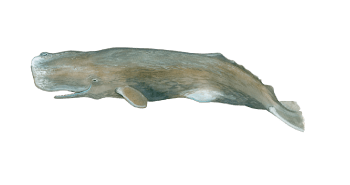
Sperm whale
(Physeter macrocephalus)
The Sperm whale is the largest toothed whale and the largest toothed predator on Earth. Fully grown sperm whale bulls can reach a length of up to 18 metres and can weigh up to 50 tons.
They can hold their breath for over an hour and are able to reach depths of nearly 2500 metres. Adult males consume about a ton of food every day and can live for up to 60 years.
Sperm whales live in groups with complex social structures, with females forming matriarchal groups with juvenile animals. Young males join other juvenile males to form bachelor pods before living a more solitary life as mature adults, only temporarily joining groups in the breeding season.
The English name of these whales can be traced back to the false assumption of whalers that these animals have a reservoir of sperm in their head. It is known today that this reservoir is in fact an organ, known as the spermaceti, which helps the whales dive, navigate, hunt and communicate.
General information
Further names: Portuguese: Cachalote-comum
Size of adults: 11 – 18 m
Prey: Large cephalopods, larger fish
Behaviour: Often encountered rafting at the surface, resting and socialising between dives. They are usually indifferent to whale-watching boats but occasionally approach us curiously, particularly calves. Sometimes seen breaching at the surface.
Range: Global. They are usually encountered in deep pelagic waters, but they also approach coastal areas or islands if the water is at least 200 metres deep. They migrate to the poles in the summer, with older males often travelling across entire oceans and crossing the equator. Females remain in tropical, sub-tropical latitudes. There are single populations that remain in the same region all year round.
Madeira: Can be observed throughout the year.
Distinctive features: Large, rectangular head that may make up one third of the total body length. Sperm whales have the largest brain of any animal. Only the narrow lower jaw has any teeth. The blowhole is shaped like a slit, and positioned on the left upper side of the head. Their blow is directed forward to the left. Their dark grey skin has deep furrows. They become paler as they age. Sperm whales have a series of ridges instead of a dorsal fin. Their broad, deeply serrated flukes rise above the surface when they start their dive.
Peculiarity: Ambergris: A solid substance consisting of the residues of the undigested remains of squids, produced in the intestines of some animals. It was formerly a valuable ingredient in the perfume industry.
Taxonomy: Suborder: Odontoceti (Toothed whales); Family: Physeteridae (Sperm whales)
Threats: Difficult to estimate worldwide populations. Despite their recovery from intensive commercial whaling the species is still listed as nearly threatened. They are still threatened by boat collisions or entanglement in fishing nets. Strandings due to noise pollution have also been reported with stranded animals often containing plastic in their gut. Their only natural predator is the orca.
